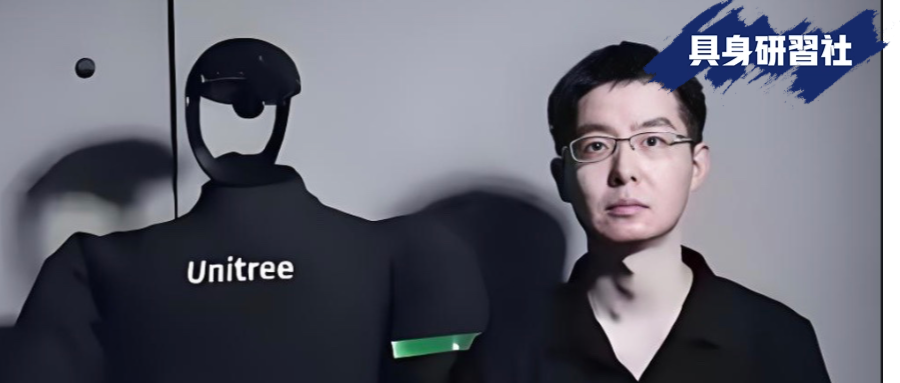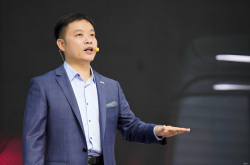Unitree: Stepping Away from the 'Idol' Spotlight
![]() 11/17 2025
11/17 2025
![]() 321
321

Some investors shared with the Embodied Intelligence Research Institute that Unitree's quest for new avenues to boost revenue is indeed welcome news. Yet, others are perplexed, feeling that Unitree is "straying off course" by not resting on its past successes and delving into ventures that might backfire.
Editor: Lv Xinyi
Following the 2025 Spring Festival Gala, Unitree Technology seemed to unlock a treasure trove of popularity. This robotics firm, once struggling with financing and leaving investors scratching their heads, has now emerged as a frontrunner in embodied intelligence, becoming a coveted asset for capital seeking stakes in established companies.
Nowadays, Wang Xingxing no longer has to justify his passion for quadruped robots or elucidate the purpose of humanoid robots.
This surge in popularity hasn't just been a windfall for Unitree Technology; it's also thrown the company into a whirlpool of public scrutiny. Over the past year, misconceptions about Unitree Technology have only deepened. The sight of the Unitree G1 throwing punches and kicks in the fighting arena, coupled with the slightly awkward yet amusing H1 on the Spring Festival Gala stage, has firmly pigeonholed Unitree as a "gimmick company."
Suddenly, Unitree's crown isn't that of a leader in embodied intelligence but rather the king of popularity within that realm.
Had popularity been the sole guiding star, Unitree could have fully embraced the path of "performing robots." After all, post-Spring Festival Gala, whether it was backflips, dancing, or humanoid robots boxing, everything seemed to spark instant discussions. However, Wang Xingxing wasn't swayed by this fleeting fame. He not only critically assessed the shortcomings of humanoid robots on numerous occasions but also chose to step out of the popularity comfort zone in his product strategy, investing resources in seemingly "mundane" areas like wheeled mobile platform research and dexterous hand development, thereby shedding the "gimmick" label.
Unitree appears determined to distance itself from the allure of popularity, and Wang Xingxing has always embodied that founder with a touch of "academic flair."
What the outside world might have missed is that Unitree's previous "gimmicks" were essentially overt displays of its hardware prowess, which is Unitree's forte and Wang Xingxing's area of expertise. With full in-house research and development of hardware, Wang Xingxing dared to challenge the overall cost of humanoid robots, and Unitree's humanoid robots had the confidence to push joint limits in public.
These technological advancements weren't for grabbing headlines but served as "technical warm-ups" for productivity scenarios. Wang Xingxing candidly stated in an interview, "Performance is a vehicle for technological validation. Our ultimate aim has always been to make robots truly functional and liberate productivity."
The Unitree Dex5 dexterous hand, unveiled in April 2025, marked a pivotal shift for Unitree, completely distancing itself from the "performance prop" image. The wheeled robot, progressing hand in hand with the dexterous hand, might have sacrificed the most gimmicky bipedal form and engaged in less attention-grabbing data collection training, but it does generate economic value.
Some investors shared with the Embodied Intelligence Research Institute that Unitree's pursuit of new revenue streams is indeed positive. Yet, others are baffled, believing Unitree is "wandering aimlessly" by not resting on its laurels and venturing into potentially risky businesses.
But is Unitree genuinely seeking new horizons, or is it charting a directionless course?
The conclusion of IPO counseling, a 50% revenue share from overseas markets, and a 70% global market share in quadruped robots all converge on one point: popularity is merely a catalyst for Unitree, not its core driving force.
Stripped of its halo, Unitree remains a company with a clear vision.
Embracing the Mundane
Compared to the launch of the R1 with its "Armor Warrior" aura and the "Destiny Awakening" of the H2, the wheeled humanoid robot G1-D unveiled by Unitree Technology seems less "buzzworthy" in terms of popularity. Some even questioned on social media if Unitree had run out of innovative ideas.
However, industry insiders are more optimistic about the commercial potential behind the G1-D, viewing it as a new growth trajectory for Unitree Technology.
Firstly, the G1-D serves as the hardware backbone for Unitree Technology's "full-stack solution for humanoid robot data collection and training" (available in standard and premium versions). It's also equipped with a comprehensive suite of data collection tools and integrated model training and inference capabilities.
The G1-D features high-definition binocular cameras in its head and high-definition cameras in its hands. Taking the premium version as an example, it can be optionally fitted with a mobile chassis, boasting a movement speed of ≤1.5m/s. The entire robot boasts 19 degrees of freedom (excluding the end effector), with 7 degrees of freedom per arm (excluding the end effector) and a maximum load capacity of approximately 3kg per arm. The G1-D adopts a combined wheeled and lifting mobile design, offering a vertical working space of 0-2m.
From a hardware configuration standpoint, Unitree seems to have veered away from its traditional path, focusing more on practicality for work. This is evident from the cameras mounted on its hands, whose primary function is to enhance operational precision and environmental adaptability. These cameras can identify the position, posture, and size of objects in real-time, enabling more precise actions like grasping, placing, and assembling. They can also assess the degree of contact between the hands and objects through images, preventing slippage or damage from excessive force.
From the perspective of this comprehensive solution, Unitree is targeting "data collection," a scenario with the fastest commercialization potential. This is a key area currently being heavily pursued in embodied intelligence and a means to overcome the bottleneck of making embodied intelligence "practical." Simply put, it's a tangible opportunity.
It's understood that Unitree's data collection tools can significantly enhance efficiency and reduce costs in scene data collection. The model training and inference tools support a seamless workflow from data processing to model training, simulation evaluation, and one-click deployment. The platform seamlessly integrates various mainstream robot open-source model frameworks, aiding developers in boosting research and development efficiency.
On Unitree Technology's official website, several suitable scenarios for the G1-D are identified, such as daily life, retail, and industry. These might seem "ordinary" and "unexciting," but they promise predictable revenue growth.
An even more "un-Unitree-like" product is the Dex3-1 three-fingered dexterous hand. When this dexterous hand was released, some investors told the Embodied Intelligence Research Institute, "It doesn't look very appealing. Maybe they shouldn't have released it." This sentiment reflects the views of some, as Unitree has left a lasting impression of being bulky, far from the lightweight pursuit of dexterous hands. Even a three-fingered end effector seems to undermine its reputation.
However, another group of investors believes that this dexterous hand doesn't represent Unitree's skill in end effectors. Its release merely indicates that Unitree is exploring the "productivity" direction. Whether it's to boost valuation or for genuine applications, it's seen as positive news.
Behind this "counterintuitive" move lies Unitree's proactive planning for the future development of embodied intelligence. The industry is currently trapped in a cyclical paradox of "data scarcity - weak model effectiveness - difficult implementation." Most companies struggle to make revolutionary breakthroughs when it comes to the core proposition of "making robots truly functional." The combination of a dexterous hand and a wheeled humanoid robot might be Unitree's eager attempt to break the deadlock.
Restrained Commercialization
Post-Spring Festival Gala, Unitree Technology didn't blindly expand its product lineup or excessively hype concepts. Instead, it continued to delve deeper into its existing technological paths and market strategies. This calmness, unperturbed by public opinion noise, stems from its dual-core driving philosophy of "technological pursuit" and "commercial rationality" since its inception.
The most prominent pragmatism is its deep cultivation of the B2B market.
Unitree Technology made a crucial strategic decision in its early stages: not to rush into the consumer market but to first focus on B2B markets like scientific research and education. This choice was highly forward-looking, as research institutions have a relatively rigid demand for robots, primarily for academic research and algorithm development. They value the open-source nature and motion performance of robots more and are relatively less sensitive to prices.
By offering cost-effective products that are easy for secondary development, Unitree Technology successfully penetrated global top universities and research institutes. Its early products secured orders from overseas tech giants like Google and NVIDIA, as well as world-renowned universities like Berkeley and MIT. This brought Unitree Technology valuable early cash flow and user feedback, forming a closed-loop ecosystem of "research and development - verification - commercialization."
For a while, there were jokes that Unitree's robots were only sold to research institutes. However, in Wang Xingxing's view, this is not only not "embarrassing" but also a wise move, as "the products have entered nearly a thousand universities worldwide, generating over 3,000 outstanding technical papers."
Of course, even within the B2B market, Unitree adopted a steady expansion strategy. After the quadruped robots were validated in the market, its industrial-grade B-series robots (such as B1 and B2) were gradually applied to broader industrial scenarios like power inspection, security patrols, fire rescue, and industrial logistics. It's reported that in the first quarter of 2025, orders for Unitree Technology's industrial inspection robots surged by 220% year-on-year. This step-by-step, in-depth strategy ensures that every move Unitree makes in the B2B market is solid.
Secondly, it has a successful overseas expansion strategy.
There's always been an implicit view in the robotics sector: the overseas market might be easier to navigate than the domestic market at this stage. This involves complex factors like more pronounced labor shortages, supply chain deficiencies, and stronger purchasing power abroad.
However, even so, few robot companies have truly gone global. In contrast, Unitree Technology has achieved remarkable international success, with overseas revenue accounting for up to 50% and products exported to multiple countries and regions. Behind this achievement is Unitree Technology's clever combination of China's supply chain advantages with global market demands.
Unitree Technology realized early on the importance of building its own factories and keeping the research and development of non-standard parts and mold development in-house. This not only solves the problem of mass production but also enhances its bargaining power in the supply chain, ultimately reducing its overall product costs. As Wang Xingxing put it, "From design to production, we optimize the entire process in the pursuit of perfection, minimizing costs."
Extreme cost control is Unitree Technology's trump card in the international market. By fully in-house researching core components (motors, reducers, lidar, etc.), Unitree has increased the localization rate of core components to over 90%, significantly reducing costs. This enables Unitree Technology to offer products with comparable performance to Boston Dynamics' Spot robots at about 1/50th of the price. This huge "price gap" gives it a strong competitive edge in the international market.
Currently, Unitree Technology is directly exporting complete products to customers through cross-border e-commerce channels like AliExpress and Amazon. In the future, as demand grows and geopolitical factors come into play, Unitree Technology may also follow the path of other tech companies going global by shipping core modules from China and assembling them at the sales location. This can meet the "local manufacturing" requirements of some regions while reducing logistics costs.
Furthermore, it is steadily exploring the consumer market.
While public opinion calls for the accelerated popularization of consumer robot products, Unitree Technology once again demonstrates its pragmatic and steady nature.
On the one hand, Unitree Technology's product prices are gradually becoming more affordable, ranging from the industrial-grade full-size humanoid H1 at hundreds of thousands of yuan to the semi-size humanoid G1 at tens of thousands of yuan, and then to the small-size R1 series at several thousand yuan. Unitree has always been pushing the price boundary of robots downward. However, on the other hand, Unitree also recognizes that "in the future, it should not be a problem for quadruped robots to drop to around 3,000-4,000 yuan and truly enter the consumer era. Currently, a quadruped robot at 10,000 yuan is still a bit expensive for ordinary consumers."
This "conflict between the left and right brain" essentially reflects Unitree's belief that the time for a large-scale entry into the consumer market has not truly arrived.
From this, it can be seen that Unitree's layout in the C-end market is gradual, rhythmic, and methodical. Combined with the currently launched "Avatar" whole-body teleoperation platform and Wang Xingxing's revelation that they are focusing on family and industrial scenarios in software development, Unitree seems to be playing a combination of moves including "continuously lowering prices, making sizes more consumer-friendly, reducing operational barriers, and improving intelligence levels." Through continuous product iteration and technological breakthroughs, it is gradually penetrating the consumer market.
In this endeavor, Unitree is actively seeking partnerships with intellectual properties (IPs) and is keen on launching cross - industry products. A prime example of its IP - collaboration efforts is its partnership with Giant Star Legend. Firstly, by integrating with high - quality IPs, robot products are transformed from mere 'tech gadgets' into 'trendy consumer items'. This not only cuts down on market education expenses but also effectively targets the young consumer demographic. Secondly, the two entities have directly set up a joint - venture company, Yuxing Entertainment Technology Co., Ltd., to jointly drive the research, development, and operation of consumer IP robots, entertainment humanoid robots, and IP - derived products.
As for cross - industry products, the 'Unitree Pump' fitness pump serves as a great illustration. It directly incorporates robot joints into the fitness equipment realm. This product is hailed as a 'gym that you can take anywhere, anytime'. Given its compact size and multi - functionality, it perfectly aligns with the current urban living environment. To date, thousands of units have been sold across various online platforms.
These strategies do more than just slash the marketing costs associated with directly promoting hardware. More crucially, they subtly nurture the market. By doing so, they lay a solid brand foundation for a potential large - scale consumer (C - end) market boom in the future.
Looking back at Unitree Technology's journey, from quadruped robots to humanoid robots, from hardware to data and models, and from the domestic market to global expansion, every step it takes is rooted in a precise understanding of market demands and an objective evaluation of its own capabilities. This pragmatic approach, which eschews the pursuit of fame and avoids blind expansion, has allowed Unitree Technology to maintain a robust financial record, achieving five consecutive years of profitability even when its valuation soared to 12 billion yuan.
Unitree Technology's practices demonstrate that true innovation goes beyond technological breakthroughs. It also involves transforming the fleeting sparks of laboratory innovation into sustainable engines for industrial development under the guidance of commercial rationality. In this fiercely competitive and volatile field, Unitree Technology's pragmatism and self - restraint may well be its core competitive advantage.







